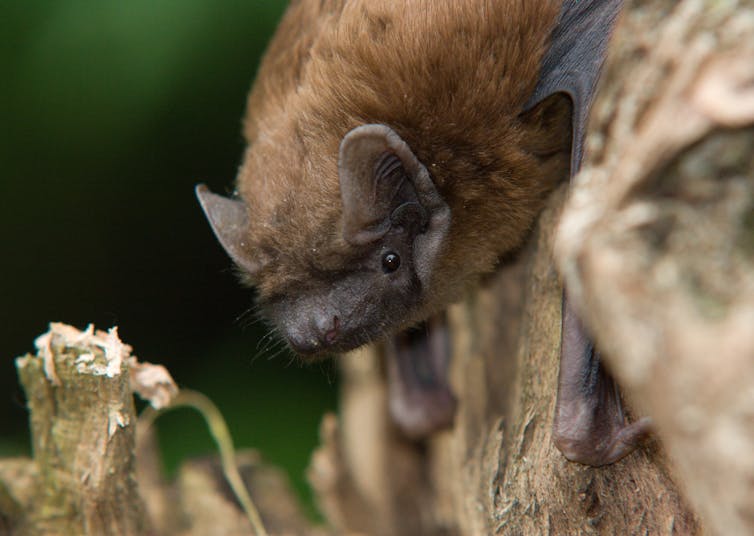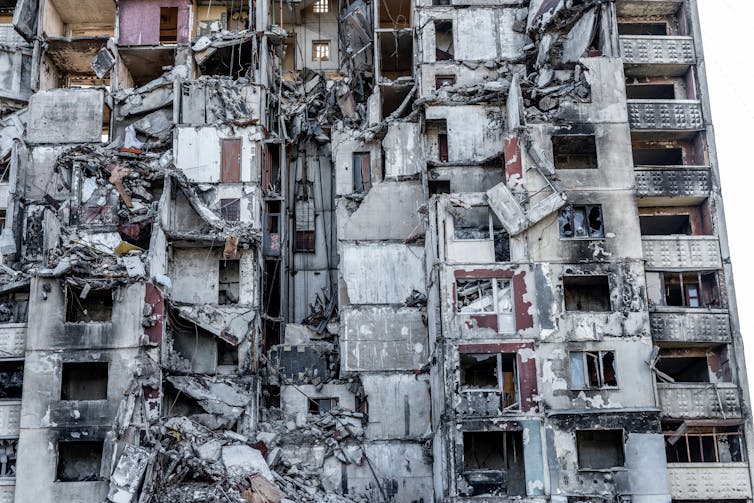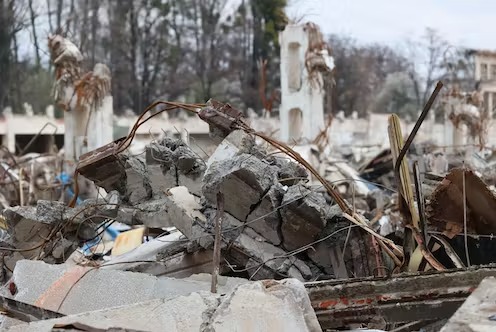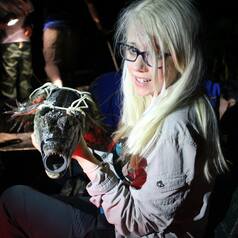Russia’s invasion of Ukraine in February 2022 has given rise to a humanitarian crisis. More than 6.2 million people have fled Ukraine as a result of heavy shelling and fighting, and an additional 5.1 million people have been internally displaced.
But wars do not only inflict suffering on humans – animals suffer too. Research by the Ukrainian Bat Rehabilitation Center (the largest project for bat conservation, research and outreach in eastern Europe) has brought into focus the plight of bats in the war-damaged city of Kharkiv. Situated only 30km from the Russian border, Kharkiv has suffered severe damage from relentless shelling throughout the conflict.
In 2022, shelling may have led directly to the killing of approximately 7,000 noctule bats (Nyctalus noctula) – a species common throughout Europe. Nearly 3,000 more bats then became trapped inside damaged buildings, where many subsequently died. More trapped bats were found in Kharkiv in 2022 than in the preceding four years combined.
Despite the challenges posed by the invasion, scientists at the Ukrainian Bat Rehabilitation Center have valiantly continued their bat conservation efforts, providing care and rehabilitation for injured bats. These efforts have also given scientists the opportunity to gather data on how the invasion has affected bats and their roosting locations.

Shelling may have led to the killing of 7,000 noctule bats in Kharkiv alone in 2022. Denisa Mikesova/Shutterstock
Bats in trouble?
Bats inhabit parts of urban areas that are particularly susceptible to attacks. Noctule bats, for instance, spend most of the winter hibernating within multistorey buildings, such as in cavities between concrete blocks.
The damage to the city began at the end of the bat hibernation season (November to April). Consequently, some of the buildings were sheltering thousands of hibernating bats when the first strikes occurred. The researchers estimate that as many as 45% of the buildings in Kharkiv that bats roost in have been completely or partially destroyed by shelling.
During this hibernation period, bats enter a state of inactivity where they reduce their heart rate and metabolic state. Once they have entered this state, they can take upwards of 20 minutes to wake up, so cannot respond to danger quickly.
From August to October, bats again gather in these buildings to mate, during a period known as “autumn swarming”. Windows left open by people as they were evacuating, or that were broken during the war, made it easy for bats to fly inside these buildings, where they subsequently became trapped.
During the autumn swarming period in 2022, three times as many bats were found trapped in buildings than the average in non-war years, with a death rate of around 30%.
Lured into a trap
In 2022, Kharkiv might also have been experiencing a higher bat population than is usual for autumn. Typically, researchers observe only a few bats in the weeks directly following the autumn swarming, a period they term the “autumn silence”. Between 2016 and 2019, they recorded sightings of fewer than 10 bats every few days during this silence.
However, during the same period in 2022, they reported sightings of over 100 bats on three occasions. This suggests that the usual autumn silence period may not have occurred.
This surge in bat numbers could have been brought about for several reasons. In the early days of the war, streetlights in Kharkiv were switched off and there was minimal lighting from houses, so the level of artificial light pollution was reduced. Artificial light pollution can disrupt bats, making them more vulnerable to predators and causing them to emerge from their roosts later at night.
The increase in bat sightings could also be explained by the growth of unmown grass and vegetation in the city during the conflict. This may have offered an increased supply of insects for the bats to feed on.

War-damaged windows became gateways for bats to enter buildings. Tatyana Vyc/Shutterstock
Protecting animals in conflict zones
Hundreds of thousands of bats are estimated to hibernate in Kharkiv each year. The proportion of bats that have been killed or trapped in the city’s war-damaged environment is therefore still relatively low.
But this same story is probably happening throughout all of Ukraine’s war-damaged cities, resulting in many more bat fatalities. So the impact the war is having on their population is still worrying.
Bats play an important role in the ecosystem, particularly because they prey on insects. A substantial decline in bat populations has the potential to result in an uptick in the population of insect pests.
Invasive insect pests carry a substantial economic burden, imposing a yearly cost of at least US$70 billion (£57 billion) to the global economy. According to research, the economic value of bats to the US agricultural sector alone is estimated at nearly US$23 billion annually.
The Ukrainian Bat Rehabilitation Center’s research has highlighted the ecological impact war can have on urban bats. However, this may apply to many other key species too.
When the time comes to repair Ukraine’s damaged cities, the significance of urban wildlife must not be overlooked. These animals are an important part of the urban environment. As people rebuild their lives, they must ensure a home is rebuilt for nature too.



 Federal Judge Declines to Immediately Halt Trump’s $300 Million White House Ballroom Project
Federal Judge Declines to Immediately Halt Trump’s $300 Million White House Ballroom Project  U.S. Offers NATO-Style Security Guarantees to Ukraine as Peace Talks Show Progress
U.S. Offers NATO-Style Security Guarantees to Ukraine as Peace Talks Show Progress  Trump Weighs Reclassifying Marijuana as Schedule III, Potentially Transforming U.S. Cannabis Industry
Trump Weighs Reclassifying Marijuana as Schedule III, Potentially Transforming U.S. Cannabis Industry  NSW to Recall Parliament for Urgent Gun and Protest Law Reforms After Bondi Beach Shooting
NSW to Recall Parliament for Urgent Gun and Protest Law Reforms After Bondi Beach Shooting  Pakistan’s Army Chief Faces Gaza Troop Dilemma Amid US Pressure
Pakistan’s Army Chief Faces Gaza Troop Dilemma Amid US Pressure  Ukraine Claims First-Ever Underwater Drone Strike on Russian Missile Submarine
Ukraine Claims First-Ever Underwater Drone Strike on Russian Missile Submarine  Jimmy Lai Convicted Under Hong Kong National Security Law in Landmark Case
Jimmy Lai Convicted Under Hong Kong National Security Law in Landmark Case  U.S. Suspends UK Technology Deal Amid Trade Disputes Under Trump Administration
U.S. Suspends UK Technology Deal Amid Trade Disputes Under Trump Administration  Korea Zinc Plans $6.78 Billion U.S. Smelter Investment With Government Partnership
Korea Zinc Plans $6.78 Billion U.S. Smelter Investment With Government Partnership  Zelenskiy Signals Willingness to Drop NATO Bid as Ukraine, U.S. Hold Crucial Peace Talks in Berlin
Zelenskiy Signals Willingness to Drop NATO Bid as Ukraine, U.S. Hold Crucial Peace Talks in Berlin  Belarus Frees Opposition Leaders Maria Kalesnikava and Viktar Babaryka in U.S.-Brokered Deal
Belarus Frees Opposition Leaders Maria Kalesnikava and Viktar Babaryka in U.S.-Brokered Deal  Trump Orders Blockade of Sanctioned Oil Tankers, Raising Venezuela Tensions and Oil Prices
Trump Orders Blockade of Sanctioned Oil Tankers, Raising Venezuela Tensions and Oil Prices  Trump’s Rob Reiner Remarks Spark Bipartisan Outrage After Tragic Deaths
Trump’s Rob Reiner Remarks Spark Bipartisan Outrage After Tragic Deaths  Trump Administration Moves to Keep TransAlta Coal Plant Running Amid Rising AI Power Demand
Trump Administration Moves to Keep TransAlta Coal Plant Running Amid Rising AI Power Demand 

































